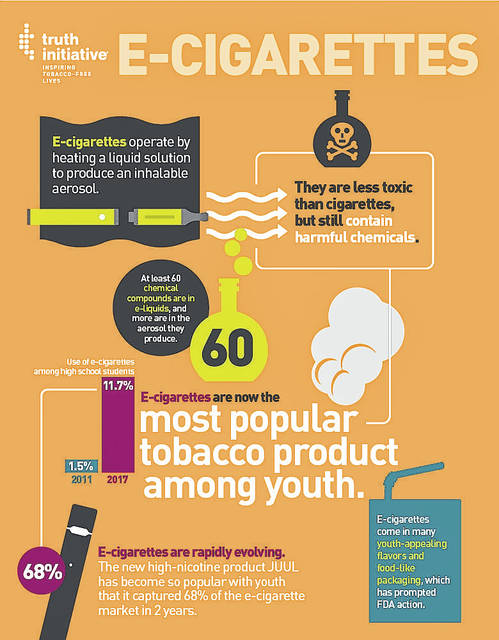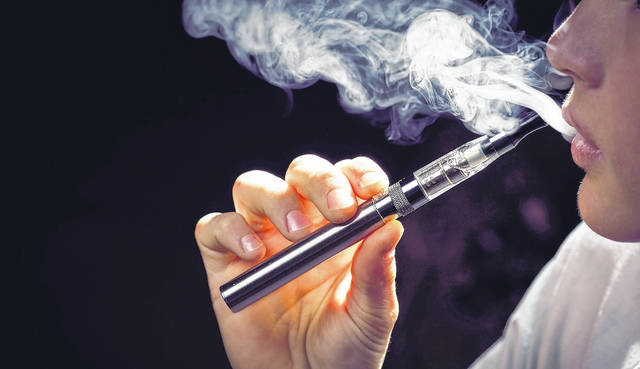Vaping, Juuling and the use of e-cigarettes may not be as safe as one would be led to believe.
A recent study shows that more than 10.8 million U.S. adults use one of those devices and more than half of those users are between the ages of 18-35. One-in-three e-cigarette users are vaping daily, according to a report in the Annals of Internal Medicine.
While many believe these devices are safer than smoking a traditional cigarette, research shows that may not be true.
According to the Food and Drug Administration (FDA), e-cigarettes [which include vape mods, Juuls, battery-powered cigarettes and vape pens] contain “detectable levels of known carcinogens and toxic chemicals to which users could be exposed.” For example, the National Center for Health Research explains that in e-cigarette cartridges marketed as “tobacco-free,” the FDA detected a toxic compound found in antifreeze, tobacco-specific compounds that have been shown to cause cancer in humans, and other toxic tobacco-specific impurities.
In 2017, a study published in the Public Library of Science Journal showed that significant levels of benzene, a well-known carcinogen, were found in the vapor produced by several popular brands of e-cigarettes.
In 2018, a preliminary study that was presented at the annual meeting of the American Chemical Society found that vaping could damage DNA. The study examined the saliva of five adults before and after a 15-minute vaping session. The saliva had an increase in potentially dangerous chemicals, such as formaldehyde and acrolein.
How dangerous are e-cigarettes?
The key difference between e-cigarettes and traditional cigarettes is the use of tobacco. E-cigarettes are tobacco-free, but it’s not just tobacco that causes cancer. Traditional cigarettes contain a laundry list of chemicals that are proven harmful, and e-cigarettes have some of these same chemicals, according to the National Center for Health Research.
The body’s reaction to many of these chemicals causes long-lasting inflammation, which can result in chronic diseases like bronchitis, emphysema and heart disease.
Researchers say the long-term effects of e-cigarettes and vaping haven’t been discovered as of yet because the product is relatively new, but many preliminary tests show the same problems developing for e-cigarette users compared to those of traditional cigarette users.
One common misconception is that e-cigarettes help people stop smoking. The FDA does not approve of e-cigarettes as a way to stop smoking and most early studies show that people who use e-cigarettes will continue to smoke because of the high amounts of nicotine in the devices.
Because they are smokeless, many assume that e-cigarettes are safe for non-smokers and the environment, but a study in the International Journal of Hygiene and Environmental Health showed that hat the use of e-cigarettes results in increased concentrations of volatile organic compounds (VOCs) and airborne particles, both of which are potentially harmful when inhaled.
A new generation …
Vaping and the use of e-cigarettes isn’t just limited to adults. An estimated 3 million- or 20 percent- of high school students are vaping. In comparison, the number was around 1.73 million in 2017.
The nicotine in e-cigarettes can be harmful to brain development in children and young adults into their early 20s, but many teenagers are unaware of the potential dangers of using the device.
According to a study conducted by The Wall Street Journal, more than two-thirds of teens who vape say that vaping can be part of a healthy lifestyle.
A study from National Institute on Drug Abuse found that 66 percent of teens who vape said only flavoring was in their e-cigarette. 13.7 percent said they didn’t know while just 13.2 percent identified that the device contained nicotine. Currently, manufacturers don’t have to report e-cig ingredients, so users don’t know what’s actually in them.
The same study found that 7 in 10 teens were highly exposed to e-cigarette advertisements and that 30.7 percent of teen e-cigarette users started smoking within six months.
Because of the increased amount of teen vaping (a 78-percent increase in high schoolers from last year), the FDA is considering several steps to cut down on what it is calling an “epidemic.” This includes offering drug therapy and imposing bans on certain products in convenience stores.


